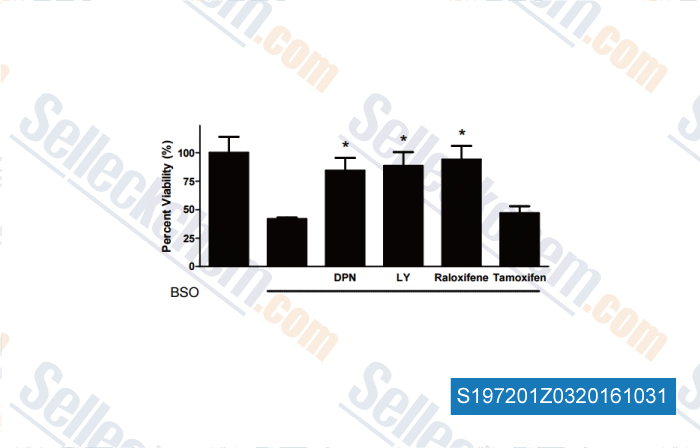|
Toll Free: (877) 796-6397 -- USA and Canada only -- |
Fax: +1-832-582-8590 Orders: +1-832-582-8158 |
Tech Support: +1-832-582-8158 Ext:3 Please provide your Order Number in the email. |
Technical Data
| Formula | C26H29NO.C6H8O7 |
|||
| Molecular Weight | 563.64 | CAS No. | 54965-24-1 | |
| Solubility (25°C)* | In vitro | DMSO | 100 mg/mL (177.41 mM) | |
| Ethanol | 5 mg/mL (8.87 mM) | |||
| Water | Insoluble | |||
|
* <1 mg/ml means slightly soluble or insoluble. * Please note that Selleck tests the solubility of all compounds in-house, and the actual solubility may differ slightly from published values. This is normal and is due to slight batch-to-batch variations. * Room temperature shipping (Stability testing shows this product can be shipped without any cooling measures.) |
||||
Preparing Stock Solutions
Biological Activity
| Description | Tamoxifen Citrate is a selective estrogen receptor modulator (SERM). Tamoxifen Citrate is also a potent Hsp90 activator and enhances the Hsp90 molecular chaperone ATPase activity. Tamoxifen induces apoptosis and autophagy. | |
|---|---|---|
| Targets |
|
|
| In vitro | Tamoxifen displays antitumor effect due to its antiestrogenic activity (ER). Values for the apparent affinity of Tamoxifen for the ER range between 30 and 0.01% of that obtained for estradiol, dependent on different ER source (species), protein concentration and condition used for assay. Binding of Tamoxifen to ER further leads to inhibition expression of estrogen-regulated genes, including growth factors and angiogenic factors secreted by the tumor that may stimulate growth by autocrine or paracrine mechanisms. Tamoxifen also directly induces programmed cell death. [1] Tamoxifen produces an inhibitory effect on MCF-7 cell [3H]thymidine incorporation and DNA polymerase activity as well as causing a reduction in DNA content of cultures and cell numbers. This inhibitory effect of Tamoxifen on MCF-7 cell growth can be readily reversed by addition of estradiol to the culture medium. 2 and 6 μM Tamoxifen reduces the proportion of cells in S phase and increases the number of cells in G1. At 10 μM, Tamoxifen causes cell death within 48 hr. [2] Tamoxifen inhibits MCF-7 growth with IC50 of ~10 nM after 10 days treatment. Tamoxifen inhibits plasminogen activator activity of MCF-7, and suppresses estradiol-stimulation of plasminogen activator activity. Tamoxifen also evokes minimal increases in cellular progesterone receptor levels. [3] Tamoxifen is able to inhibit the growth of prostate cancer cell PC3, PC3-M, and DU145 with IC50 ranged from 5.5-10 μM, which is related to its inhibition of protein kinase C and induction of p21(waf1/cip1). [4] |
|
| In vivo | Tamoxifen administration to rapidly growing, estradiol-stimulated MCF-7 xenografts results in a dose-dependent retardation or cessation of tumor growth by significantly decreasing tumor cell proliferation in tumor. Tamoxifen treatment results in a slowing of tumor growth (tumor doubling time, 12 days), a significant increase in tumor potential doubling time (Tpot) (6.6 days), and a decrease in labeling index (%LI) (to 8%) by 23 days posttreatment, compared with untreated mice which shows a volume doubling time of 5 days, a Tpot of 2.3 days, and a %LI of 23%. [5] Tamoxifen has not only antiestrogenic but also estrogenic properties depending on the species, tissue, and gene. Tamoxifen displays favorable effects on bone and serum lipid concentrations and stimulation endometrium. [1] |
Protocol (from reference)
| Kinase Assay: |
|
|---|---|
| Cell Assay: |
|
| Animal Study: |
|
References
Customer Product Validation

-
, , University of North Texas Health Science Center, 2014.
Selleck's Tamoxifen Citrate has been cited by 23 publications
| Mcam stabilizes luminal progenitor breast cancer phenotypes via Ck2 control and Src/Akt/Stat3 attenuation [ bioRxiv, 2024, 2023.05.10.540211] | PubMed: 38562809 |
| The phenotype of the most common human ADAR1p150 Zα mutation P193A in mice is partially penetrant [ EMBO Rep, 2023, 24(5):e55835] | PubMed: 36975179 |
| Smoothened antagonist sonidegib affects the development of D. melanogaster larvae via suppression of epidermis formation [ Pestic Biochem Physiol, 2023, 194:105462] | PubMed: 37532307 |
| Generation of a new Adar1p150 - /- mouse demonstrates isoform-specific roles in embryonic development and adult homeostasis [ RNA, 2023, 29(9):1325-1338.] | PubMed: 37290963 |
| Generation of a new Adar1p150-/- mouse demonstrates isoform-specific roles in embryonic development and adult homeostasis [ RNA, 2023, rna.079509.122] | PubMed: 37290963 |
| Over-expression of ADAR1 in mice does not initiate or accelerate cancer formation in vivo [ NAR Cancer, 2023, 5(2):zcad023] | PubMed: 37275274 |
| Over-expression of ADAR1 in mice does not initiate or accelerate cancer formation in vivo [ NAR Cancer, 2023, 5(2):zcad023] | PubMed: 37275274 |
| Bacterial diet modulates tamoxifen-induced death via host fatty acid metabolism [ Nat Commun, 2022, 13(1):5595] | PubMed: 36151093 |
| Srsf2P95H/+ co-operates with loss of TET2 to promote myeloid bias and initiate a chronic myelomonocytic leukemia-like disease in mice [ Leukemia, 2022, 10.1038/s41375-022-01727-6] | PubMed: 36271153 |
| Nuclear FGFR1 Regulates Gene Transcription and Promotes Antiestrogen Resistance in ER+ Breast Cancer [ Clin Cancer Res, 2021, 10.1158/1078-0432.CCR-20-3905] | PubMed: 34011560 |
RETURN POLICY
Selleck Chemical’s Unconditional Return Policy ensures a smooth online shopping experience for our customers. If you are in any way unsatisfied with your purchase, you may return any item(s) within 7 days of receiving it. In the event of product quality issues, either protocol related or product related problems, you may return any item(s) within 365 days from the original purchase date. Please follow the instructions below when returning products.
SHIPPING AND STORAGE
Selleck products are transported at room temperature. If you receive the product at room temperature, please rest assured, the Selleck Quality Inspection Department has conducted experiments to verify that the normal temperature placement of one month will not affect the biological activity of powder products. After collecting, please store the product according to the requirements described in the datasheet. Most Selleck products are stable under the recommended conditions.
NOT FOR HUMAN, VETERINARY DIAGNOSTIC OR THERAPEUTIC USE.
